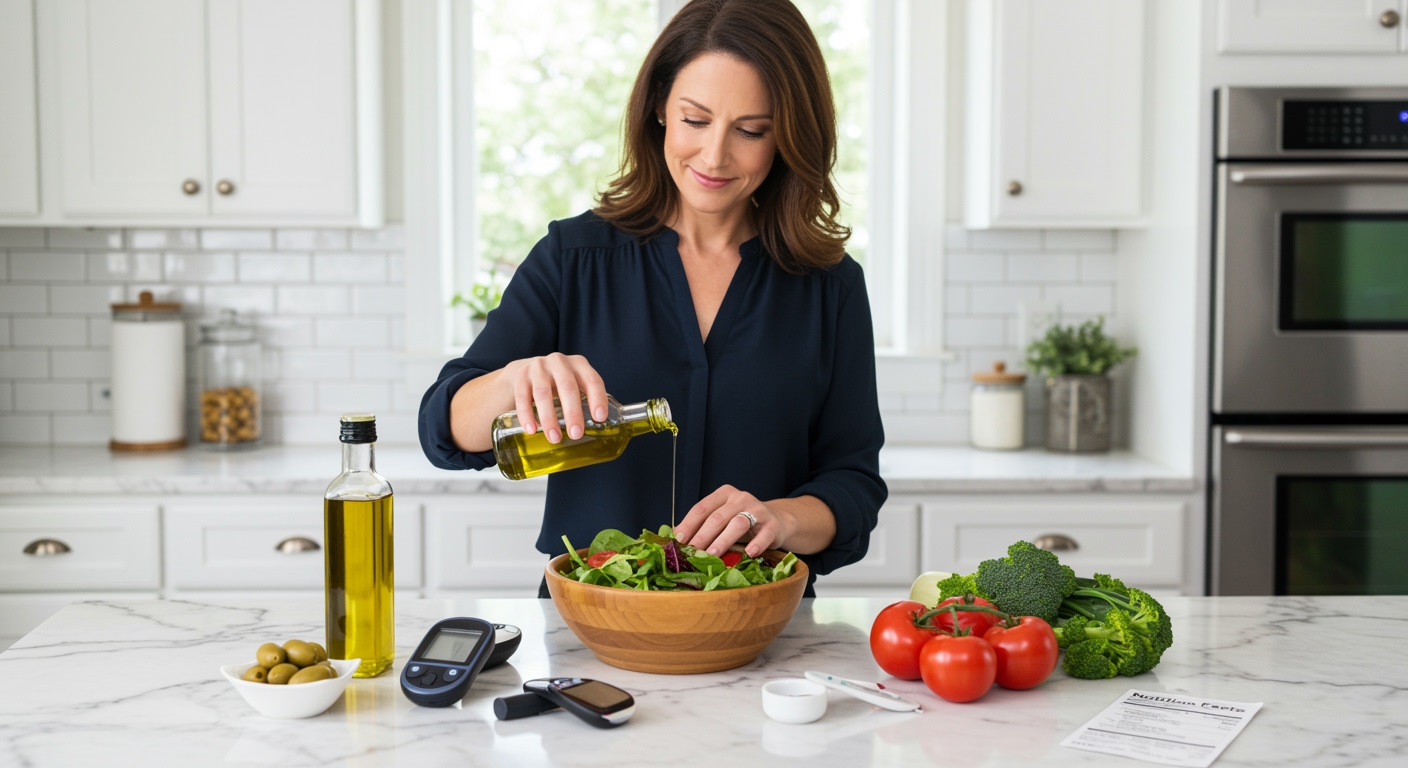✪ Key Takeaway: Olive oil can benefit diabetes management when used properly, but portion control and quality matter significantly.
Introduction
You pour olive oil on your salad thinking you are making a healthy choice for your diabetes.
But then you wonder if this golden liquid is actually helping or hurting your blood sugar levels.
Hi, I am Abdur, your nutrition coach and today I am going to explain exactly how olive oil affects diabetes and what you need to know to use it safely.
Does Olive Oil Raise Blood Sugar Levels?
Olive oil has a glycemic index of zero, which means it does not directly raise your blood sugar levels.
This happens because olive oil contains no carbohydrates.
Your body breaks down carbohydrates into glucose, but fats like olive oil follow a completely different metabolic pathway.
When you consume olive oil, your digestive system breaks it down into fatty acids and glycerol.
These components do not trigger the same insulin response that carbohydrates do.
However, olive oil can still affect your blood sugar indirectly through its impact on insulin sensitivity and meal composition.
Research shows that meals containing olive oil may actually help slow down glucose absorption from other foods you eat at the same time.
✪ Fact: Pure olive oil contains zero carbohydrates and has no direct impact on blood glucose levels.
How Does Olive Oil Help With Insulin Resistance?
Insulin resistance occurs when your cells become less responsive to insulin, making it harder to control blood sugar.
Extra virgin olive oil contains powerful antioxidants called polyphenols that can help improve insulin sensitivity.
These polyphenols work by reducing inflammation in your body, particularly in fat tissue and muscle cells.
When inflammation decreases, your cells can respond better to insulin signals.
Studies have shown that people who consume olive oil regularly have lower levels of inflammatory markers in their blood.
The monounsaturated fats in olive oil also help improve the cell membrane composition, making it easier for glucose to enter cells.
This means your body needs less insulin to achieve the same blood sugar control, which is exactly what you want when managing diabetes.
✪ Pro Tip: Choose extra virgin olive oil for maximum polyphenol content and anti-inflammatory benefits.
What About Calories And Weight Management?
One tablespoon of olive oil contains approximately 120 calories, all from fat.
This high calorie density means you can easily overconsume calories if you are not careful with portions.
Weight management is crucial for diabetes control because excess body weight worsens insulin resistance.
However, the monounsaturated fats in olive oil can actually help with satiety, making you feel full longer after meals.
This satiety effect can help you eat less overall throughout the day, which supports healthy weight management.
Research indicates that people following Mediterranean diets rich in olive oil often maintain healthier body weights compared to those on low-fat diets.
The key is using olive oil to replace less healthy fats rather than adding it on top of your current calorie intake.
✪ Note: Measure olive oil portions carefully to avoid unintentional weight gain that could worsen diabetes control.
Which Type Of Olive Oil Is Best For Diabetics?
Not all olive oils are created equal when it comes to diabetes management.
Extra virgin olive oil is your best choice because it undergoes minimal processing and retains the highest levels of beneficial compounds.
This type contains the most polyphenols, which provide the anti-inflammatory and insulin-sensitizing effects.
Regular olive oil or light olive oil has been refined and processed, removing many of these protective compounds.
When shopping, look for olive oil that comes in dark glass bottles or tin containers to protect it from light damage.
Fresh olive oil should have a fruity, slightly peppery taste and a golden to green color.
Store your olive oil in a cool, dark place and use it within two years of the harvest date for maximum nutritional benefits.
✪ Pro Tip: Look for harvest dates rather than expiration dates to ensure you get the freshest olive oil possible.
How Much Olive Oil Should Diabetics Consume Daily?
The optimal amount of olive oil for diabetics depends on your individual calorie needs and overall diet.
Most nutrition experts recommend 1-2 tablespoons per day as a reasonable amount for most adults.
This provides approximately 120-240 calories from healthy monounsaturated fats.
You can use this amount for cooking, salad dressings, or drizzling over cooked vegetables.
The Mediterranean diet, which has shown benefits for diabetes management, typically includes about 2-4 tablespoons of olive oil daily.
However, this amount works within the context of a diet rich in vegetables, fruits, whole grains, and lean proteins.
If you are trying to lose weight, you may need to use less olive oil to stay within your calorie targets while still getting the health benefits.
✪ Note: Start with one tablespoon daily and adjust based on your blood sugar response and weight management goals.
The Bottom Line
Olive oil can be a valuable part of a diabetes-friendly diet when used appropriately and in proper portions.
Quality nutrition is not about perfection but about making consistently better choices that support your long-term health goals.
I would love to hear about your experiences with olive oil and diabetes management, so please share your thoughts, questions, or feedback in the comments below.
References
At NutritionCrown, we use quality and credible sources to ensure our content is accurate and trustworthy. Below are the sources referenced in creating this article:
- MDVIP: Studies Explain How Olive Oil May Help Type 2 Diabetes Control
- PMC: Olive Oil and Diabetes Research
- About Olive Oil: Insulin Resistance Research
- January AI: Olive Oil Glycemic Index





